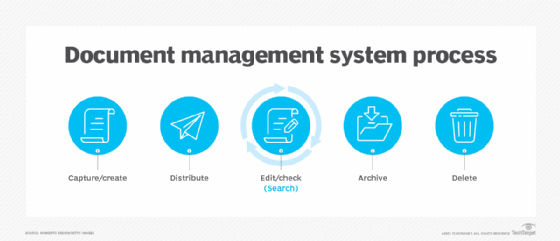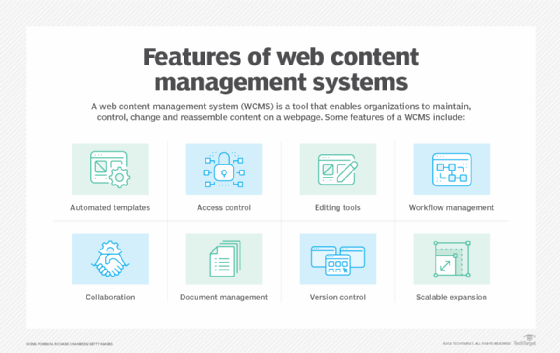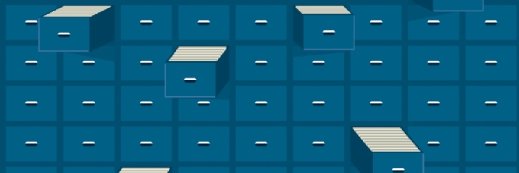Document management vs. content management: How they differ
While document and content management are part of a larger enterprise content management strategy, the two systems handle different types of information.
A document management system and content management system sound like interchangeable terms, but they're not.
A document management system (DMS) and content management system (CMS) can certainly perform similar functions, and the two systems do have some overlap. It's important, however, to understand the differences between the two technologies.
What is a document management system?
A document management system stores, manages and tracks electronic documents, including emails, images and voice files. It can also track scanned images of paper documents.
Document management systems typically have the following capabilities:
- A DMS captures content by processing images of scanned paper documents. Many DMSes use optical character recognition (OCR) software to convert these digital images into readable and editable text. Other advanced scanning capabilities include optical mark recognition and handprint character recognition.
- A DMS can have built-in workflow modules or integrate with workflow management tools.
- A DMS has version control features, enabling users or administrators to view document versions and revert to a previous version if necessary.
- A DMS can enable users to index content by category, type and keyword to enable better search and organization.
Another related term is enterprise document management (EDM), which oversees paper and digital documents within an organization for easy retention and retrieval in the event of a compliance audit or other legal incident. This archiving strategy focuses on regulatory compliance from a document perspective. It should answer questions such as, "How long should a business keep documents for?" and, "How will the business recover documents in the event of a disaster?"

Document management systems are sometimes sold as standalone products. But, today, they've largely been incorporated into the broader category of enterprise content management (ECM). Most ECM vendors, such as Alfresco, M-Files and Microsoft SharePoint, offer a DMS component.
This article is part of
What is enterprise content management? Guide to ECM
What is a content management system?
A content management system is an application that enables users to create, manage and publish digital content on a website. CMSes feature a graphical user interface so nontechnical users can edit, publish and manage content without knowing how to code.
A CMS has two key components:
- A content management application (CMA) is the intuitive interface that users see, enabling them to add content to a site and manage it.
- A content delivery application (CDA) is the back-end infrastructure that assembles the code, displays it to website visitors and stores it.
A related term is web content management system (WCMS). WCMS and CMS are nearly interchangeable terms. The only difference is a WCMS is a type of CMS that is specifically dedicated to website content.
A CMS is used within the larger scope of ECM. Therefore, CMS can be considered a subcategory of ECM software. Popular CMS vendors include WordPress, Joomla and Drupal.

Similarities of DMSes and CMSes
Document and content management systems overlap in the sense that they are both components of an overall ECM strategy. They both perform the following functions:
- Manage digital assets.
- Offer content security.
- Provide a centralized storage system for content.
- Create, retain and distribute information.
- Simplify the accessibility of search and retrieval.
- Automate workflows.
Additionally, both DMSes and CMSes are available as cloud-based SaaS subscriptions.
DMS vs. CMS: Key differences
While CMS and DMS functions overlap, the systems and their use cases are not interchangeable. The key differences between CMSes and DMSes include the following:
- A CMS handles structured and unstructured data. The major difference between a CMS and a DMS is the type of information each system can handle. A DMS works best with structured data and documents, such as PDF files, Microsoft Word documents and PowerPoint presentations. It can digitize these files and track them throughout the content lifecycle. A CMS, on the other hand, can handle a wider range of electronic information, including both unstructured and structured content. In addition to the documents a DMS can handle, a CMS manages rich media, such as audio files, video, flash and web content.
- A DMS has advanced content-capturing features. Most document management software incorporates imaging and scanning features such as OCR, while a CMS typically does not.
- They have different goals. The main goals of a CMS are to store, retrieve and publish content, whereas a DMS focuses on workflow management and compliance.
Which is right for you: EDM, ECM or both?
Leadership teams might wonder how to sort through the alphabet soup of DMS, ECM, EDM and CMS, and how to choose the right technology for their organization and business processes.
EDM or DMS is a component of ECM. ECM is the convergence of various technologies, including the following:
- Records management.
- Web content management.
- Digital asset management.
- Document management.
Therefore, large enterprises that need all these components should buy an ECM platform. Companies that focus less on external publication and content marketing might want a standalone DMS to track their records and documents.
Content services are also an option. A content services platform (CSP) combines ECM capabilities with RESTful APIs. It's a set of microservices and applications that can be a single product suite or a collection of applications that share common APIs. CSPs can include both document management and ECM.
Editor's note: This article was updated to remove outdated information and improve the reader experience.
Erica Mixon is a former senior site editor at TechTarget.








